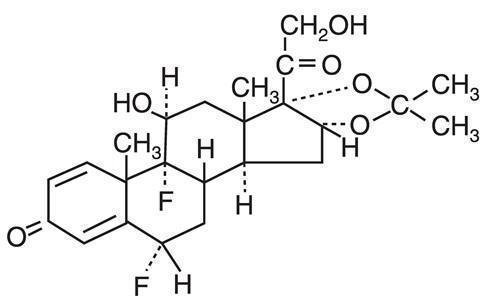Capex Shampoo
Generic name:fluocinolone acetonide
Dosage form: shampoo
Drug class:Topical steroids
Medically reviewed by Drugs.com. Last updated on May 23, 2022.
On This Page
DESCRIPTION:
Capex® Shampoo 0.01% is supplied as a shampoo formulation with a 12 mg fluocinolone acetonide capsule which is emptied into the shampoo base by the pharmacist at the time of dispensing. After mixing, Capex® Shampoo contains fluocinolone acetonide(6α,9-Difluoro-11β,16α, 17,21-tetrahydroxypregna-1,4-diene-3, 20-dione cyclic 16,17-acetal with acetone), a synthetic fluorinated corticosteroid for topical dermatologic use. The corticosteroids constitute a class of primarily synthetic steroids used topically as an anti-inflammatory and antipruritic agents.
Chemically, Capex® Shampoo mixture is C24H30F2O6. It has the following structural formula:

Fluocinolone acetonide in Capex® Shampoo has the molecular weight of 452.50. It is a white crystalline powder that is odorless, stable in light and melts at 270°F with decomposition; soluble in alcohol, acetone and methanol; slightly soluble in chloroform; insoluble in water.
Each fluocinolone capsule contains 12 mg of fluocinolone acetonide, 548 mg of dibasic calcium phosphate dihydrate USP, and 240 mg of talc USP. The shampoo base contains aluminum acetate dibasic, benzalkonium chloride solution, boric acid, citric acid anhydrous, cocamido-ether-sulfate complex, cocoamine oxide, lauramide DEA, magnesium aluminum silicate, methylparaben, oat flour, propylene glycol, propylparaben, purified water, and fragrances, with D&C Yellow #10 and FD&C Blue #1 as coloring.
CLINICAL PHARMACOLOGY:
Like other topical corticosteroids, fluocinolone acetonide has anti-inflammatory, antipruritic and vasoconstrictive properties. The mechanism of the anti-inflammatory activity of the topical steroids, in general, is unclear. However corticosteroids are thought to act by the induction of phospholipase A2 inhibitory proteins, collectively called lipocortins. It is postulated that these proteins control the biosynthesis of potent mediators of inflammation such as prostaglandins and leukotrienes by inhibiting the release of their common p...



